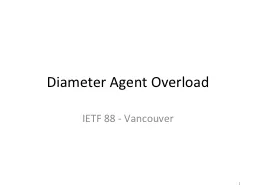

IETF 88 Vancouver 1 Goal Get consensus from the working group that Agent overload needs to be addressed If so get guidance on the best path forward 2 Background DOCDT decided to not address handling of overloaded agents in ID: 357715
Download Presentation The PPT/PDF document "Diameter Agent Overload" is the property of its rightful owner. Permission is granted to download and print the materials on this web site for personal, non-commercial use only, and to display it on your personal computer provided you do not modify the materials and that you retain all copyright notices contained in the materials. By downloading content from our website, you accept the terms of this agreement.
Slide1
Diameter Agent Overload
IETF 88 - Vancouver
1Slide2
Goal
Get consensus from the working group that Agent overload needs to be addressed
If so, get guidance on the best path forward
2Slide3
Background
DOC-DT decided to not address handling of overloaded agents in
base
DOIC specification
.
3Slide4
Assertion
A complete solution to handling Diameter overload requires addressing overload of all nodes in a Diameter network, including agents
.
4Slide5
Requirements –
An agent is a Diameter node.
REQ 1: The solution MUST provide a communication method for Diameter nodes to exchange load and overload information
.
REQ
12: When a single network node fails, goes into overload, or suffers from reduced processing capacity, the solution MUST make it possible to limit the impact of this on other nodes in the network. This helps to prevent a small-scale failure from becoming a widespread outage
.
Other requirements also apply.5Slide6
Question 1
Do we agree that we need to address the handling of Agent Overload?
6Slide7
Behavior
Minimal new behavior required in clients
Behavior for a client is the same as the case where there is a direct connection between the client and multiple servers and the client gets a realm overload report from one of the servers.
Overload abatement is handled by peer on a hop-by-hop basis
.
Agents are required to inspect overload reports and act on those from peer agents.
No change in loss abatement algorithm for throttled requests
.7Slide8
Question 2
How should agent overload handling be specified?
Option 1 – As an extension
Option 2 – As part of the base DOIC specification
8Slide9
BACKUP SLIDES
9Slide10
Use Cases
Single Agent
Redundant Agents
Agent Chains
Interaction between agent overload and end-point overload
10Slide11
Agent Overload
Multiple Agents
Client
Agent1
Architecture
Server
Agent2
Client has active connection to both agent 1 and agent 2
Client shares the load between the two agents
The load distribution mechanism is local policy to the client
11Slide12
Agent Overload
Multiple Agents
Client
Agent1
Server
xxR
x%
xxA
Client sends x percent of traffic through agent 1
Agent2
No overload
xxR
y%
Client sends y percent of traffic through agent 2
x
+ y = 100%
xxA
12Slide13
Agent Overload
Multiple Agents
Client
Agent1
Server
xxR
xxA
xxA
OLR (A1, R=20%)
Agent OVL report contains
r
equested reduction
Agent2
xxR
y%+20%
xxA
Agent1 becomes overloaded
xxR
x%-20%
Client adjusts distribution of load between agents based on the agent overload report
xxA
13Slide14
Agent
OverloadMultiple Agents
Client
Agent1
Server
xxR
xxA
xxA
OLR (A1, R=60%)
Agent OVL report contains
r
equested reduction
Agent2
Agent1 becomes 60% overloaded
xxR
Throttle at (x% * .6) + (y% * .6))
At this point the combined agent overload requires throttling to a level the agents are able to handle
xxR
xxA
xxA
OLR (A2, R=60%)
Agent OVL report contains
r
equested reduction
Agent2 becomes 60% overloaded
14Slide15
Agent Overload UC4
Agent Chain
Client
Agent1
Architecture
Agent2-2
Server1
Agent2-1
15Slide16
Agent Overload
Agent Chain
Agent 1
Agent2-1
Server
xxR
xxA
xxA
OLR (A1, R=60%)
Agent OVL report contains
r
equested reduction
Agent 1 acts on the report and removes it from
the message
Agent2-2
Agent1 becomes 60% overloaded
xxR
Throttle at (x% * .6) + (y% * .6))
At this point the combined agent overload requires throttling to a level the agents are able to handle
xxR
xxA
xxA
OLR (A2, R=60%)
Agent OVL report contains
r
equested reduction
Agent 1 acts on the report and removes it from
t
he message
Agent2 becomes 60% overloaded
Client
xxR
xxA
16